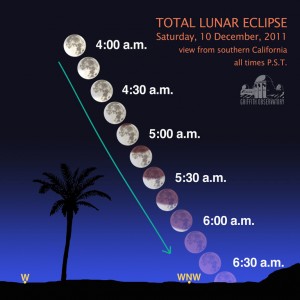![]()
LISTEN to this week’s Sky Report
Here is what’s happening in the skies of Southern California:
The full moon will pass through earth’s shadow early on Saturday morning, December 10, producing a spectacular total eclipse of the moon, about half of which will be visible from Los Angeles before sunrise. To watch the eclipse, you will want a view toward an unobstructed horizon facing west-northwest. Technically, the eclipse starts at 3:33 a.m., P.S.T. when the upper edge (northeastern limb) of the moon contacts the fuzzy outer edge of earth’s shadow–the penumbra. It is unlikely, however, that anything will seem unusual about the full moon until shortly after 4:00 a.m. when the moon is deep enough within the penumbra for a subtle dimming of the upper part to be seen. The dramatic part of the eclipse gets underway at 4:45 a.m., when the moon touches the umbra, the well defined, dark, inner shadow of the earth. This will make take a definite bite out of the moon that will spread across the entire moon over the next 51 minutes. While this is happening, the moon will draw closer to the west-northwest horizon and dawn will start to brighten the sky at 5:19 a.m. Around that time, a look by unaided eye or binoculars should reveal that the part of the moon in the umbra seems to glow with a red or coppery hue, sometimes tinged with blue at its edge. This is because of our atmosphere bending and filtering the sunlight like a lens, throwing the light of all the world’s sunrises and sunsets into what would otherwise be an unlit shadow. The eclipse becomes total at 6:06 a.m., and it is then that the moon should appear most colorful¬–perched only 8 degrees above the horizon. After that, the faint glow of the moon will be competing with its decreasing altitude and increasing brightness of dawn. Mid-eclipse occurs at 6:31 a.m. with the moon only 3 degrees high. If you have a perfect horizon, the sun will rise in the east-southeast at 6:48 a.m., and the moon will touch the horizon directly opposite to the sun at the same time–nicely illustrating the shadow-making role of our planet in the sun–earth–moon geometry.
Griffith Observatory, with the help of the Los Angeles astronomical Society and the Sidewalk Astronomers, will provide public viewing from the Observatory’s lawn and rooftop Zeiss telescope. The Café at the End of the Universe and the Cosmic Emporium store will be open for your comfort and holiday shopping needs! The Vermont Avenue entrance of Griffith Park will open especially for this event at 4:30 a.m., Saturday, December 10.
The Geminid meteor shower reaches its peak during the night and early morning hours Tuesday/Wednesday, December 13/14. Bright moonlight will make only the brightest meteors visible, but it may still be a worthwhile show from 10 p.m. until about 3 a.m. even from suburban back yards. Be on the lookout for early Geminid meteors during the lunar eclipse.
The bright planets visible during evening twilight (between 5:00 and 6:00 p.m.) include Venus, low in the southwest, and Jupiter, in Aries the Ram, high in the south-southeast. Mars appears just before dawn as a bright reddish star near the center of Leo the lion, high in the south, and the ringed planet Saturn appears about 30 degrees high in the southeast, to the left of – and rivaling – Virgo the Maiden’s bright star, Spica.
Free public viewing of the sun during the day and of the moon, planets and other celestial objects at night, is available in clear weather, five nights a week (Wednesday through Sunday) through Griffith Observatory’s telescopes before 9:45 p.m. Check our website for our schedule. The next public star party of the Los Angeles Astronomical Society and the Sidewalk Astronomers is scheduled for Saturday, January 28. As mentioned, Griffith Observatory and the astronomy clubs will also host viewing of the total lunar eclipse from 4:30 a.m. until sunrise on Saturday, December 10.
The Sky Report is updated every Wednesday. It can be read-and now heard-on our website by following the Sky Information links. From Griffith Observatory, I’m Anthony Cook, and I can be reached at griffithobserver@gmail.com.

